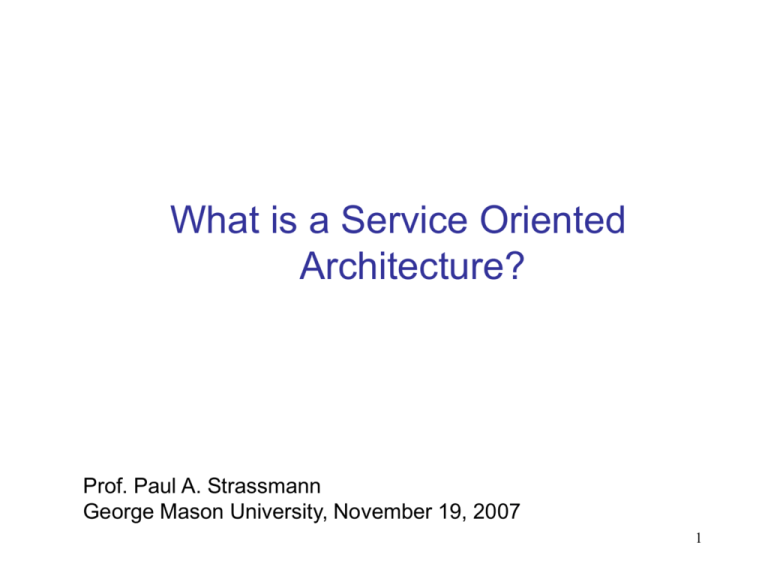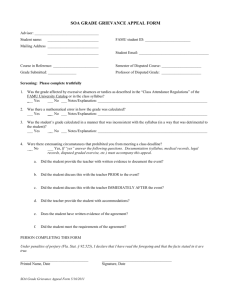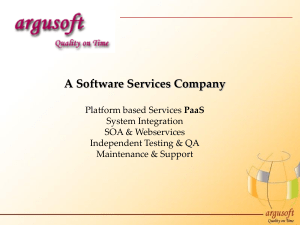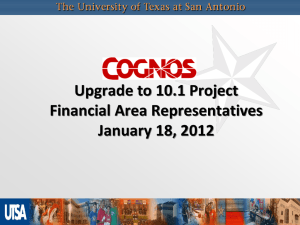Service Oriented Architecture (SOA) Explained
advertisement

What is a Service Oriented Architecture? Prof. Paul A. Strassmann George Mason University, November 19, 2007 1 Problems Addressed by a Service Oriented Architecture 2 Purpose of Architecture: To Manage Interdependencies Suppliers Manufacturing Management Dealers Customer Logistics Logistics Engineeering Parts Financing Parts Financial Engineeering Financial Financing Warranties Logistics Repair Insurance Taxes Outsourcing Sourcing Marketing Maintenance Maintenance 3 Directions of System Architecture 1960 - 1980 •Organization Focus •Mainframe Centric •Internal Use •Unique Data 1990 - 2000 •Process Focus •Client Server •Partial Connectivity •EDI File Transfer 2010 - 2050 •Distributed Functions •Data Centric •Universal Interoperability •Real-time Connectivity 4 Data Interoperability Expands as Response Time Shrinks 5 Interoperability Does not Scale 6 What is a Service Oriented Architecture (SOA)? • A method of design, deployment, and management of both applications and the software infrastructure where: – All software is organized into business services that are network accessible and executable. – Service interfaces are based on public standards for interoperability. 7 Key Characteristics of SOA • Quality of service, security and performance are specified. • Software infrastructure is responsible for managing. • Services are cataloged and discoverable. • Data are cataloged and discoverable. • Protocols use only industry standards. 8 What is a “Service”? • A Service is a reusable component. • A Service changes business data from one state to another. • A Service is the only way how data is accessed. • If you can describe a component in WSDL, it is a Service. 9 Information Technology is Not SOA Business Mission Information Management SOA Information Systems Systems Design Computing & Communications Informatio n Technolog y 10 Current Infrastructure Costs are Excessive ($ Millions, I.T. Costs) Function SOA Total 07 Spending % of Total Spending Warfighter Missions $10,876 36% IT Infrastructure $14,185 47% Logistics $2,377 8% HR Management $1,834 6% Finance & Administration $1,036 3% $185 1% $30,492 100% Other Total DoD FY 07 11 Contractors Will Build Separate Infrastructures without SOA 12 Why Getting SOA Will be Difficult • Managing for Projects: – Software: 1 - 4 years – Hardware: 3 - 5 years; – Communications: 1 - 3 years; – Project Managers: 2 - 4 years; – Reliable funding: 1 - 4 years; – User turnover: 30%/year; – Security risks: 1 minute or less. • Managing for SOA: – Data: forever. – Infrastructure: 10+ years. 13 Why Managing Business Systems is Difficult? • 40 Million lines of code in Windows XP is unknowable. • Testing application (3 Million lines) requires >1015 tests. • Probability correct data entry for a supply item is <65%. • There are >100 formats that identify a person in DoD. • Output / Office Worker: >30 e-messages /day. 14 How to View Organizing for SOA PERSONAL LEVEL Private Applications and Files Privacy and Individual Security Barrier Graphic InfoWindow, Personal Tools, Inquiry Languages Customized Applications, Prototyping Tools, Local Applications and Files VARIETY HERE LOCAL LEVEL Applications Security Barrier Applications Development & Maintenance APPLICATION LEVEL Business Security Barrier Service A Process Security Barrier Service B OSD Functional Process A Functional Process B Functional Process C Functional Process D Corporate Policy, Corporate Standards, Reference Models, Data Management and Tools, Integrated Systems Configuration Data Base, Shared Computing and Telecommunications Industry Standards, Commercial Off-the-Shelf Products and Services BUSINESS LEVEL PROCESS LEVEL ENTERPRISE LEVEL STABILITY HERE GLOBAL LEVEL 15 SOA Must Reflect Timing Private Applications and Files PERSONAL Graphic InfoWindow, Personal Tools, Inquiry Languages Customized Applications, Prototyping Tools, Local Applications and Files Applications Development & Maintenance Business A Business B Infrastructure Support LOCAL APPLICATION SHORT TERM ADAPTABILITY & TECHNOLOGY SIMPLICITY BUSINESS Functional Process A Functional Process B Functional Process C PROCESS Functional Process D Corporate Policy, Corporate Standards, Reference Models, Data Management and Tools, Integrated Systems Configuration Data Base, Shared Computing and Telecommunications, Security and Survivability Industry Standards, Commercial Off-the-Shelf Products and Services ENTERPRISE LONG TERM STABILITY & TECHNOLOGY COMPLEXITY GLOBAL 16 SOA Must Reflect Conflicting Interests Personal Local Organizations Missions Enterprise 17 DoD Concept How to Organize for SOA Programs Army, Navy Air Force Agencies Combatant Commands Business Mission WarFighting MissionIntelligence Mission Focus of this Presentation Enterprise Information Environment 18 Organization of Infrastructure Services Infrastructure Services (Enterprise Information) Data Services Security Services Computing Services Communication Services Application Services 19 Organization of Data Services Data Services Discovery Services Management Services Collaboration Services Interoperability Services Semantic Services 20 Data Interoperability Policies • • • • • • • Data are an enterprise resource. Single-point entry of unique data. Enterprise certification of all data definitions. Data stewardship defines data custodians. Zero defects at point of entry. De-conflict data at source, not at higher levels. Data aggregations from sources data, not from reports. 21 Example of Data Pollution Citizen? Frequency US 9,451 Yes 228 USA 158 U.S.A. 128 U.S. 88 United States 20 (US) 5 Green Card 2 Naturalized 1 Applied 1 ??? 323 22 What Data? 23 Data Concepts • Data Element Definition – Text associated with a unique data element within a data dictionary that describes the data element, give it a specific meaning and differentiates it from other data elements. Definition is precise, concise, non-circular, and unambiguous. (ISO/IEC 11179 Metadata Registry specification) • Data Element Registry – A label kept by a registration authority that describes a unique meaning and representation of data elements, including registration identifiers, definitions, names, value domains, syntax, ontology and metadata attributes. (ISO 11179-1). 24 Data and Services Deployment Principles • Data, services and applications belong to the Enterprise. • Information is a strategic asset. • Data and applications cannot be coupled to each other. • Interfaces must be independent of implementation. • Data must be visible outside of the applications. • Semantics and syntax is defined by a community of interest. • Data must be understandable and trusted. 25 Organization of Security Services Security Services Transfer Services Protection Services Certification Services Systems Assurance Authentication Services 26 Security Services = Information Assurance • Conduct Attack/Event Response • Ensure timely detection and appropriate response to attacks. • Manage measures required to minimize the network’s vulnerability. • Secure Information Exchanges • Secure information exchanges that occur on the network with a level of protection that is matched to the risk of compromise. • Provide Authorization and Non-Repudiation Services • Identify and confirm a user's authorization to access the network. 27 Organization of Computing Services Computing Services Computing Facilities Resource Planning Control & Quality Configuration Services Financial Management 28 Computing Services • Provide Adaptable Hosting Environments – Global facilities for hosting to the “edge”. – Virtual environments for data centers. • Distributed Computing Infrastructure – Data storage, and shared spaces for information sharing. • Shared Computing Infrastructure Resources – Access shared resources regardless of access device. 29 Organization of Communication Services Communication Services Interoperability Services Spectrum Management Connectivity Arrangements Continuity of Services Resource Management 30 Network Services Implementation • From point-to-point communications (push communications) to network-centric processes (pull communications). • Data posted to shared space for retrieval. • Network controls assure data synchronization and access security. 31 Network Control is the Key 32 Communication Services • Provide Information Transport – Transport information, data and services anywhere. – Ensures transport between end-user devices and servers. – Expand the infrastructure for on-demand capacity. 33 Organization of Application Services Application Services Component Repository Code Binding Services Maintenance Management Portals Experimental Services 34 Application Services and Tools • Provide Common End User Interface Tools – Application generators, test suites, error identification, application components and standard utilities. • Common end-user Interface Tools. – E-mail, collaboration tools, information dashboards, Intranet portals, etc. 35 Example of Development Tools • Business Process Execution Language, BPEL, is an executable modeling language. Through XML it enables code generation. Traditional Approach - Hard-coded decision logic - Developed by IT - Maintained by IT - Managed by IT - Dependent upon custom logs capture - Hard to modify and reuse BPEL Approach - Externalized decision logic - Modeled by business analysts - Maintained by policy managers - Managed by IT - Automatic logs and process - Easy to modify and reuse 36 A Few Key SOA Protocols • Universal Description, Discovery, and Integration, UDDI. Defines the publication and discovery of web service implementations. • The Web Services Description Language, WSDL, is an XMLbased language that defines Web Services. • SOAP is the Service Oriented Architecture Protocol. It is a key SOA in which a network node (the client) sends a request to another node (the server). • The Lightweight Directory Access Protocol, or LDAP is protocol for querying and modifying directory services. • Extract, Transform, and Load, ETL, is a process of moving data from a legacy system and loading it into a SOA application. 37 SOA Interoperability Goals for the Department of Defense • Interoperability of solutions across the DoD strategic goal. • Rules for sharing of data and services across the enterprise. • Enforcement of standards. • All data, services, and applications shall be accessible, understandable, and trusted. • Global Information Grid for sharing of information with Federal Departments, Department of Homeland Security, the Intelligence Community, state and local governments, allied, coalition, non-governmental organizations (NGOs), academic, research and 38 business partners. Example of Customizable Web Services (www.salesforce.com) 39 Why SOA Saves Code • Provides a standard way of interacting with shared software. • Enables software to become building blocks for reuse. • Shifts focus to application assembly rather than design. • Creates new applications out of existing components. • Integrates with applications in other enterprises. 40 Preservation of Assets is the Purpose of SOA What the Customer Trains to Apply; Applications Usage Short-term Asset (An Enterprise Function) >70% of Cost Open Systems, Equipment, Software, Communications Obsolescent Commodity Asset (Outsource According to Architecture) <20% of Cost Data & Systems Integration; Communications Infrastructure Architecture Long - term Asset (An Enterprise Function) <10% of Cost 41 Impacts of Information Technologies • • • • Information drives economic “arms race”. Obsolete assets will be discarded. Collaboration favors global consolidation. I.T. becomes an economic weapon. 42 A Historical Perspective 43






